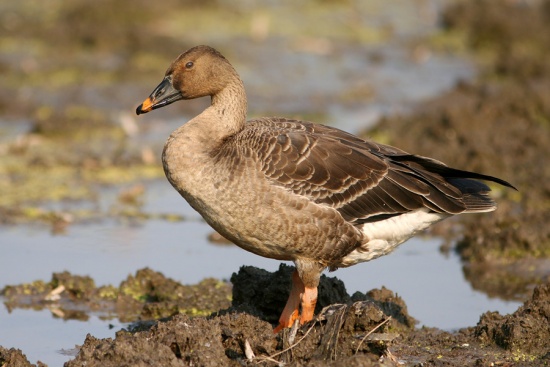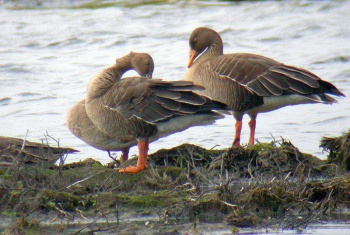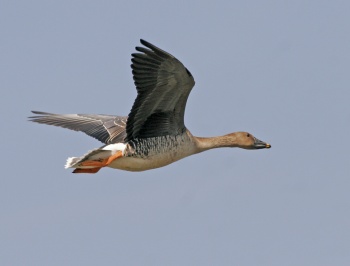(→Taxonomy: Added footnotes) |
(Added clearer image.) |
||
| Line 1: | Line 1: | ||
| − | [[Image: | + | [[Image:IMG 3842.jpg|thumb|550px|right|''A. f. middendorffi''<br />Photo © by {{user|Ayuwat+J|Ayuwat Jearwattanakanok}}<br />Beppu, Oita, [[Japan]], 31 October 2010]] |
;[[:Category:Anser|Anser]] fabalis | ;[[:Category:Anser|Anser]] fabalis | ||
'''Includes Middendorff's Goose''' | '''Includes Middendorff's Goose''' | ||
==Identification== | ==Identification== | ||
| − | |||
====Taiga form (''A. f. fabilis'')==== | ====Taiga form (''A. f. fabilis'')==== | ||
| + | [[Image:Anser fabalis fabalis, Finland.jpg|thumb|350px|right|''A. f. fabilis''<br />Photo © by {{user|aritervo|aritervo}}<br />Kajaani, [[Finland]], 16 August 2007]] | ||
*Dark goose with a long neck | *Dark goose with a long neck | ||
*Head, neck, and back are dark brownish | *Head, neck, and back are dark brownish | ||
| Line 21: | Line 21: | ||
'''Juveniles''' of both subspecies are more scaly on the back and always lack any white at the base of the bill. | '''Juveniles''' of both subspecies are more scaly on the back and always lack any white at the base of the bill. | ||
| + | [[Image:31557bean-goose 8053.jpg|thumb|350px|right|''A. f. middendorffi''<br />Photo © by {{user|Peter+de+Haas|Peter de Haas}}<br />Upo wetland [[Korea]], 20 February 2007]] | ||
====Similar species==== | ====Similar species==== | ||
[[Tundra Bean Goose]], formerly considered a subspecies, is similar but has a shorter and heavier neck, a shorter bill, rarely more than a small orange spot near the tip of the bill which is always sharply defined. | [[Tundra Bean Goose]], formerly considered a subspecies, is similar but has a shorter and heavier neck, a shorter bill, rarely more than a small orange spot near the tip of the bill which is always sharply defined. | ||
Revision as of 22:27, 4 April 2019
- Anser fabalis
Includes Middendorff's Goose
Identification
Taiga form (A. f. fabilis)
- Dark goose with a long neck
- Head, neck, and back are dark brownish
- Lightest on the back
- Underside is lighter
- Bill is quite long
- Very variable with regards to extent of black and orange; some extensively orange with little black
- Orange often found on the distal part and almost always more extensive than in Tundra Bean Goose
- May be a narrow white edge between bill and feathers on the head, especially above the bill
In flight, tail pattern is conspicuous: narrow white terminal band, broader black band, and the innermost part white. Vent and undertail coverts white. Both upper and lower sides of wings are dark, without much contrast between coverts and primaries/secondaries.
Middendorff's Goose
The subspecies A. f. middendorffii has recently been proposed for splitting from this species[2][3].
- Bill is much larger than the other two, often looking like a direct continuation of the crown.
- Longest neck
Juveniles of both subspecies are more scaly on the back and always lack any white at the base of the bill.
Similar species
Tundra Bean Goose, formerly considered a subspecies, is similar but has a shorter and heavier neck, a shorter bill, rarely more than a small orange spot near the tip of the bill which is always sharply defined.
Distribution
Breeds in the taiga (boreal forests) of Scandinavia east to Russia and Siberia (east of Lake Baikal).
In northern Europe, subspecies A. f. fabilis winters in southern Sweden, Denmark, and northern Poland west to northeastern Netherlands, generally to the north and east of where Tundra Bean Goose winters. In Britain, two small populations of Taiga Bean Goose regularly winter in the Falkirk area of Scotland, and at Buckenham Marshes (by Strumpshaw Fen) in southeast Norfolk, England. Overall, it is quite rare compared to Tundra Bean Goose; in the Netherlands, wintering numbers are around 500-1000, rising to 3,500 in severe winters (when birds from further northeast are pushed southwest), compared to around 30,000 Tundra Bean Geese.
Asian populations (A. f. johanseni and A. f. middendorffii) winter locally in Kazakhstan in central Asia, and more widely in central and eastern China, South Korea, and Japan.
Taxonomy
Three subspecies are accepted[1]:
- A. f. fabilis: northern forest zone (taiga) west of the Urals
- A. f. johanseni: northern forest zone (taiga) east of the Urals to Lake Baikal (included in A. f. middendorffii by some authorities)
- A. f. middendorffii: northern forest zone (taiga) east of johanseni
In the past considered conspecific with Tundra Bean Goose and named as just Bean Goose Anser fabalis. Pink-footed Goose was also sometimes included in Bean Goose by some authors. Carboneras & Kirwan (2019) make a good case for the traditional approach of only one species, an approach also adopted by H&M4. [4][5]
Habitat
Breeds in humid openings in northern forest, especially birch and coniferous forests. Winters in agricultural areas, mostly grassy fields.
Behaviour
Diet
In winter, it grazes in crops such as grass, cereals and potatoes; bean field stubbles were particularly liked by the fabilis form giving rise to its name. Middendorff's Goose is particularly fond of marshes.
Vocalisation
<flashmp3>Anser fabalis (song).mp3</flashmp3>
Listen in an external program
References
- Clements, J. F., T. S. Schulenberg, M. J. Iliff, D. Roberson, T. A. Fredericks, B. L. Sullivan, and C. L. Wood. 2018. The eBird/Clements checklist of birds of the world: v2018. Downloaded from http://www.birds.cornell.edu/clementschecklist/download/
- Ruokonen, M., Litvin, K., & Aarvak, T. (2008). Taxonomy of the bean goose – pink-footed goose. Molecular Phylogenetics and Evolution 48: 554–562 doi: 10.1016/j.ympev.2008.04.038
- Birdforum thread discussing the taxonomy of the Bean Goose complex including the possibility of splitting it in three species.
- Carboneras, C. & Kirwan, G.M. (2019). Bean Goose (Anser fabalis). In: del Hoyo, J., Elliott, A., Sargatal, J., Christie, D.A. & de Juana, E. (eds.). Handbook of the Birds of the World Alive. Lynx Edicions, Barcelona. (retrieved from https://www.hbw.com/node/52811 on 29 March 2019).
- Christidis et al. 2018. The Howard and Moore Complete Checklist of the Birds of the World, version 4.1 (Downloadable checklist). Accessed from https://www.howardandmoore.org.
Recommended Citation
- BirdForum Opus contributors. (2024) Taiga Bean Goose. In: BirdForum, the forum for wild birds and birding. Retrieved 29 May 2024 from https://www.birdforum.net/opus/Taiga_Bean_Goose
External Links






